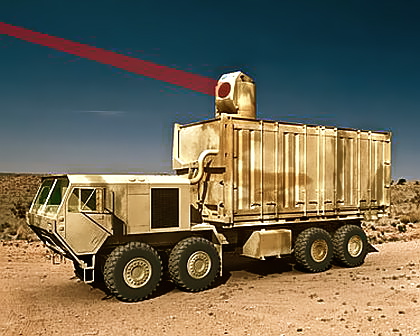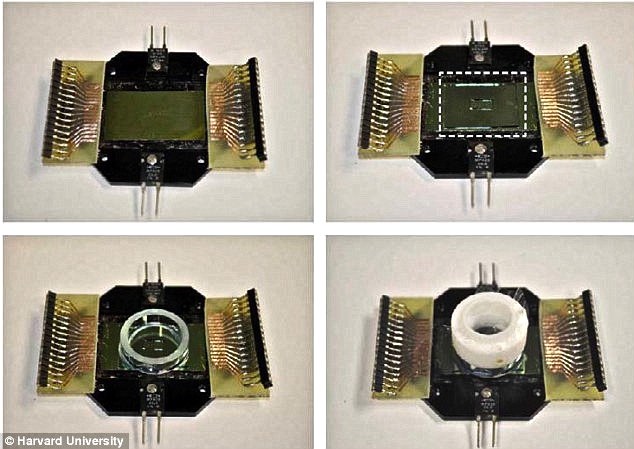| |
|

New Invisibility Cloak Hides Objects from Human View
July 28, 2011 - Excerpt
For the first time, scientists have devised an invisibility cloak
material that hides objects from detection using light that is visible
to humans. The new device is a leap forward in cloaking materials,
according to a report in the ACS journal Nano Letters.
The carpet cloak works by concealing an object under the layers, and
bending light waves away from the bump that the object makes, so that
the cloak appears flat and smooth.
Although the study cloaked a microscopic object roughly the diameter of
a red blood cell, the device demonstrates that it may be "capable of
cloaking any object underneath a reflective carpet lay".
|
|
 |
|
‘Invisibility Cloak’ Uses Mirages to Make Objects Vanish
Carbon Nanotubes were electrically stimulated to
bend light rays away from the object behind the cloaking device, leading
to total invisibility
Researchers from the University of Dallas in Texas have
hijacked one of nature’s most intriguing phenomena — the mirage — to
make an invisibility cloak. It can hide objects from view, works best
underwater and even has a near-instant on/off switch.
The nanotubes — one-molecule-thick sheets of carbon wrapped up into
cylindrical tube — have the density of air but the strength of steel.
They’re also excellent conductors, making them an ideal material to
exploit the “mirage effect". Using these nanotube sheets, concealment
can be realized over the entire optical range and rapidly turned on and
off at will, using either electrical heating or a pulse of
electromagnetic radiation.
Watch: video of the invisible cloaking
device |
 |
|

Invisible Tanks Could be on Battlefield Within Five Years
January 2011
Excerpt
British military scientists plan to develop an army of "invisible" tanks ready
for use on the battlefield within five years.
Armoured vehicles will use a new technolog known as "e-camouflage" which
deploys a form "electronic ink" to render a vehicle "invisible".
Highly sophisticated electronic sensors attached to the tank's hull will project
images of the surrounding environment back onto the outside of the vehicle
enabling it to merge into the landscape and evade attack. |
|
 |

Nathan Landy with Cloaking Device |
Making a Better Invisibility Cloak
The first functional "cloaking" device reported
by Duke University electrical engineers in 2006 worked like a
charm, but it wasn't perfect. Now a member of that laboratory
has developed a new design that ties up one of the major loose
ends from the original device.
These new findings could be important in transforming how light
or other waves can be controlled or transmitted. Just as
traditional wires gave way to fiber optics, the new
meta-material could revolutionize the transmission of light and
waves.
The Duke team has extensive experience in creating
"meta-materials," human-made objects that have properties often
absent in natural ones. Structures incorporating meta-materials
can be designed to guide electromagnetic waves around an object,
only to have them emerge on the other side as if they had passed
through an empty volume of space, thereby cloaking the object.
Landy has now reduced the occurrence of reflections by using a
different fabrication strategy. "We built the cloak, and it
worked," he said. "It split light into two waves which traveled
around an object in the center and re-emerged as the single wave
with minimal loss due to reflections."
The researchers are now working to apply the principles learned
in the latest experiments to three dimensions, a much greater
challenge than in a two-dimensional device. |
|
|
 |
 |
| |
Scientists Create First Free-Standing 3-D Cloak
Researchers in the US have, for the first time, cloaked a
three-dimensional object standing in free space, bringing the
much-talked-about invisibility cloak one step closer to reality.
This study shows how ordinary objects can be cloaked in their natural
environment in all directions and from all of an observer's positions.
|
|
 |
|
Pentagon Scientists Use ‘Time Hole’
to Make Events Disappear
The research marks “a significant step
towards full spatio-temporal cloaking.”
Soldiers could one day conduct covert operations in complete secrecy,
now that Pentagon-backed physicists have figured out how to mask entire
events by distorting light.
This is the first time that scientists have succeeded in masking an
event, though research teams have in recent years made remarkable
strides in cloaking objects. Where events are concerned, concealment
relies on changing the speed of light. They split apart a beam of light,
making half the beam move extremely quickly and the other half more
slowly. The “gap” between those speeds is where the event in question is
hidden. |
 |
 |
 |
|
A 'Time Cloak' which bends light to tear holes in
time has been created
It could allow secret messages to be sent via fiber optic cables
It can hide a continuous stream of events at telecommunications data
rates
It can cloak 46 per cent of the entire time axis and conceal
pseudorandom digital data at a rate of 12.7 gigabits per second |
Time cloaking is a way of manipulating electromagnetic radiation in
time and space so a collection of events or happenings are concealed
from people who are observing from a distance.
In theory a thief could use time cloaking techniques to enter a
building, steal cash or valuables and exit before their image was
recorded on security cameras.
The concept employs the science of meta-materials in which light can be
forced to behave in ways that it does not behave naturally.
Now research has proven it's possible, scientists are looking for ways
to expand the amount of time that can be cloaked.
The potential to cloak real-world messages introduces temporal cloaking
into the sphere of practical application with immediate ramifications in
secure communications.
There is concern about terrorists using time cloaking technology to
steal and record sensitive information without being detected.
Professor Weiner said: ‘Future cloaks based on our arrangement have the
potential for significant improvements both in terms of operational
bandwidth and the duration of the cloaked region. |
 |
|
 |
|
 |
|
 |
 |
|
Ray Guns have been the Staple of
Science Fiction for almost a Century
Movies and TV have featured disintegrator rays, plasma
rifles, pulse rifles and many other devices.
Common to all these exotic weapons is directed energy, generally in the
form of a laser beam, or other mysterious and powerful rays, capable of
killing people and destroying objects. |
| Research is on in a number of countries to develop practical weapons
based on the principle of the ray gun. These Directed Energy Weapons
(DEW) already use laser beams and other concentrated sources to exploit
the human body’s natural response to pain and intense heat. While the
United States is at the forefront of the technological race to develop
laser weapons, it is not the only nation to venture down this path.
Russia is known to be working on aerial military lasers and it is a safe
bet that China and Israel are too. |
|
Advanced Tactical Laser on Boeing
747-400F |
|
Laser Weapons are by far the Most Promising variety
of DEW currently under Investigation… |
| Why do laser guns and other DEW devices seem so much more attractive
than conventional projectile weapons such as guns and missiles? For one
thing, DEWs can be precisely targeted. It is claimed of some airborne
laser weapon systems, that while engaging a moving truck, the attacker
may choose whether to simply burn the tires and immobilize the vehicle,
hit the engine and disable it or set the fuel tank alight and trigger an
inferno. Similarly, while targeting a person, energy output can be
controlled at will, high power to kill or low power to deliver an
intensely unpleasant experience and serve as a stern warning. Since
laser beams travel at the speed of light, evading an accurately aimed
laser weapon is impossible. The range of a laser gun is much greater
than that of a conventional weapon. And although practical range is
subject to atmospheric conditions and power availability, even
long-range laser ‘firing’ needs hardly any compensation and wind
velocity has negligible effect. Lasers are also capable of great
flexibility. For instance, their focus can be changed to select an
effective area either much smaller or much larger than bullet or
projectile-based weaponry. Since laser beams produce neither sound nor
visible light, the user’s location would not be compromised. And if
sufficient power were made available, for instance by refueling the host
platform, laser weapons would never run out of ‘ammunition’.
|
|
Fighting with Light
Particle-beam weapons are a type of DEW that use charged
or neutral particles to destroy a target. They are theoretically
possible, but no practical examples are known to exist. Plasma weapons
fire a beam, bolt or stream of sub-atomic particles. Sonic and
ultrasonic DEW weapons use a focused beam of sound or ultrasound to
injure, incapacitate or even kill an opponent.
Since the weapon needs neither propellant nor
explosives, it can continue firing so long as power is available. As
compared with hundreds of thousands of dollars expended by a single
missile launch, a laser shot might cost just a dollar. |
 |
|
All at Sea |
Advanced Tactical Laser . . .
C130-Hercules |
The environment at sea may be unfavorable. Heaving seas, saltwater,
sea spray, fog and rain – all impede a laser weapon’s accuracy and
effectiveness. Most current lasers are inadequate against a variety of
threats because they are not powerful enough. That is why laser weapons
are intended to supplement rather than replace conventional weapons
onboard a ship. Lasers also need to become much more efficient.
Most laser weapons are flexible. At the flick of a switch they can be
used for less-lethal applications such as weapon targeting or to heat
objects so as to make them easier for infra-red trackers to acquire or
merely to dazzle pilots. Electronic systems, electro-optical sensors and
infrared systems on enemy aircraft, surface vehicles, ships and
submarines can all be degraded. |
| An attacker with an airborne laser weapon has several advantages. To
begin with, although the beam is silent and invisible, it enables a
terrifyingly precise attack that can leave a deep impression on eye
witnesses. The spectacular effects on a human target include
instantaneous burst-combustion of clothing and rapid death through
violent trauma. Whenever a shock attack happens, especially such a
mysterious one, quick evaluation and decisions are demanded. However, a
doctor or investigator arriving at the scene of a directed-energy strike
would be unlikely to have any previous experience of ‘death by laser
attack’. There would be no bullet or weapon fragments to identify the
originator of the attack. The investigators might not even categorically
conclude that a laser was involved. This would give the attacker the
added benefit of plausibly denying involvement in the attack. A top terrorist is out on an evening walk. The area is remote and
there are no potential threats in sight, so the heavily-armed bodyguards
maintain a discreet distance from their leader, allowing him a few
moments of privacy – perhaps to mentally plan his next attack.
Suddenly the guards hear a scream and see their chief writhing on the
ground in flames. While some run to his assistance, the rest quickly
scour the surrounding area and scan the clear sky. They see nothing,
hear nothing. Then it is all over. Their leader appears to have been
felled literally by a bolt from the blue. The only clues on the body are
smoldering clothing and intense burn marks akin to a lightning strike.
High up in the sky, a distant plane turns away and relays a ‘mission
successful’ message to its command post thousands of miles away.
Such a fictional attack using a directed-energy beam may not be possible
today. But the US Air Force has long been exploring laser weapons. In
2008, the Advanced Tactical Laser (ATL) that generated infra-red light
of lethal intensity was fitted on a C-130 Hercules transport plane. It
was succeeded by a larger version, inside a modified Boeing 747-400F,
that was intended against missile launches. |
|

Energy Weapons: Not Just For Buck Rogers Any More
By Gary Lai
The missile was
approaching fast and gathering speed on a column of flame. Inside a
trailer, miles away, it appeared on the radar screen of a soldier
on-watch. From its radar signature, he realized it was a Katyusha, a
ten-foot long missile launched from a truck and capable of delivering a
powerful explosive charge or chemical weapon. Acting quickly, he
commanded a device resembling a large spotlight mounted on the roof of
the trailer to whir into motion. After panning for a few moments, the
device locked onto the distant rocket arching overhead. It shot an
invisible high-energy laser beam into the side of the Katyusha,
following the target even as it continued to fly at several times the
speed of sound. Seconds later, the missile exploded into a ball of
flame, disintegrating into shards which rained harmlessly onto the
desert below.
Is this a scene taken from a science fiction story? Not at all.
Instead, it's a description of an actual test which took place over
three years ago of the Tactical High Energy Laser (THEL)

 |
|

Navy’s Next Laser Mashes Up Machine Guns and Death Rays
A machine gun is a powerful weapon, particularly on board a Navy
ship. But it suffers from what some would consider a design flaw: It’s not a
laser cannon. Until now. It’s the next move in the Navy’s dicey long-term
mission to protect surface ships with death rays
A solid-state laser succeeded in blasting the engine off a small watercraft
during an April test off the coast of California. That laser, operated by the
eggheads at the Office of Naval Research, used a mere 15-kilowatt beam to
disable the boat from a mile away.
The Navy considers the future defense of its fleet to be deadly rays of energy.
And if they need to be paired with old-fashioned 25mm guns, sailors probably
won’t complain. |
 |
 |
| U.S. Navy researchers are taking the first steps toward a tactical
laser weapon mounted on a humvee-like maneuverable combat vehicle to
protect moving U.S. Marine Corps task forces from unmanned aerial
vehicles (UAVs), cruise missiles, and other weapons that are difficult
to pick up on radar. |
The U.S. Army is investigating laser vehicles such as the Boeing
truck-mounted High Energy Laser Technology Demonstrator (HEL TD) to
defend Army troops against UAVs, rockets, artillery shells, mortars, and
similar threats.
The big difference, however, is firing on the move. The HEL TD, which
has been demonstrated at White Sands Missile Range in New Mexico, is
designed to move to deployed Army sites and engage targets from fixed
sites. The future Marine Corps G-BAD is envisioned to fire laser weapons
while maneuvering with moving Marine Corps air-ground task forces.
While the Army HEL-TD program seeks to mount a 10-kilowatt laser weapon
on a 10-ton eight-wheel truck to engage targets from a distance, the
G-BAD initiative seeks to mount a short-range air-defense laser at least
as strong as 25 kilowatts on a four-wheel Joint Light Tactical Vehicle (JLTV),
which the Army, Marines, and Special Operations forces are developing to
replace the Humvee. |
 |
| Navy researchers are looking at a G-BAD laser weapon that can fire
at full power for as long as two minutes, followed by a 20-minute
recharge to 80 percent of total capacity. The laser weapon should not
weigh more than 2,500 pounds, and needs to fit in the JLTV's cargo area. |
|
The Rail Gun launcher uses a form of electromagnetic energy known as
the Lorentz force, the combination of electric and magnetic forces on a
point charge—for power, to hurl a 23-pound projectile at speeds
exceeding Mach 7. The electromagnetic Rail Gun represents an incredible
new offensive capability for the U.S. Navy. |
The Navy likes the weapon for several reasons, not the least of which it
has a range of 100 miles and doesn’t require explosive warheads. That
makes it far safer for sailors, and cheaper for taxpayers. According to
the Navy, each 18-inch projectile costs about $25,000, compared to
$500,000 to $1.5 million for conventional missiles.
“Frankly, we think it might be the right time for them to know what
we’ve been doing behind closed doors in a Star Wars fashion,” said
Klunder. “It’s now reality. It’s not science fiction. It’s real and you
can look at it.” |
|
The nightmare defeat of fleets
disabled by computer viruses, a premise of the popular TV show
Battlestar Galactica, is haunting some in the US Navy. Air gap jumping
malware may undermine one of the pillars of America's military might. |
| The concern over potential vulnerability of US warship was voiced by
retired Capt. Mark Hagerott at the Defense One conference. He cited
reports of a new type of computer virus, which may be able to spread
using ultrasonic waves emitted by built-in speakers. |
"That would disrupt the world balance of power if you could begin to
jump the air gap," he said.
The new virus infects computer firmware and shows unusual behavior,
including an apparent ability to jump the air gap. An infected computer could
exchange encrypted packets of information with another infected
computer, even after it had its WiFi and Bluetooth cards removed and
mains unplugged. "The air-gapped machine is acting like it's connected to the
internet. We were slightly disabling bits of the
components of the system. It would not let us disable some things.
Things kept getting fixed automatically as soon as we tried to break
them. It was weird."This kind of cyber-attack "gives you a nonlethal warfare capacity at
sea," Peter Singer, a Brookings Institution national security analyst,
said in an interview after speaking at the Defense One Summit.
Commanders could order something like, "Don't let this enemy fleet seize
these island chains, but also don't let it turn into a shooting war." |
 |
Hagerott speculates. US
fleets may be forced to go back to instrumentation used in the early
1900s in response to a crippling hacker exploit, which could shut down
or even hijack its software.
Using high-frequency sound for communication has a historic record. For
instance the very first TV remote controls utilized it rather than
infrared light. Currently however ultrasound communication is restricted
to underwater environment, due to range restrictions and available
alternatives using radio waves. |
|
 |
|
 |
|
AlphaDog Military Robot
The Legged Squad Support System, a robot being
developed by Boston Dynamics with funding from DARPA and the US Marine
Corps.
One of the things that places a limit on how far a
military patrol can roam is the amount of gear like food, water, and
ammo they can carry with them. The military is working on getting some
devices like robots into the field that will be able to carry packs and
supplies for soldiers over any terrain. Robotics manufacturer
Boston Dynamics has long been developing a quadrupedic, autonomous robot
for hauling around military gear.
The robot can now carry up to four hundred pounds of
gear over rough terrain. The robot has enough power to navigate the
terrain carrying the gear for missions up to 20 miles lasting up to 24
hours. The Alpha Dog has GPS navigation capability and computer vision
so it can follow the squad automatically.
Check out the video to see the Alpha Dog in action |
 |
|
 |
 |
Robots may become self-governing devices with built-in firearms in
massive numbers worldwide. Yet, robots’ picking who to destroy on the
battlefield is a recipe for disaster. Killer robots, flying robots… what
robots with self-determining weaponry would mean.
The technology we have today could definitely lead to the autonomous
armed robots of tomorrow, they come with their own set of unpredictable
flaws. Software today is extremely complicated and it behaves in ways
people don’t expect.
Bearing in mind the implications of autonomous weaponry, it’s disturbing
that the final decision is left in the hands of militaries and wealthy
corporations. Fortunately, Human Rights Watch joined with the Harvard
Law School International Human Rights Clinic, and released a 50 page
report called Losing Humanity: The Case Against Killer Robots.
Human Rights Watch and the International Human Rights Clinic are asking
for an international treaty against the use, production, and development
of fully autonomous weapons. In addition, they’d like for nations to put
policies and laws in effect which would prevent uncontrollable, armed
robots from becoming operable.
“We don’t think machines, however high tech they get, will be able to
follow international law designed to protect civilians in war, we think
they would undermine non-legal checks for example they don’t have
compassion, which is a significant check on killing of civilians. And
it’s also very difficult to hold fully autonomous weapons, killer
robots, accountable for their actions—so it creates an accountability
gap which can undermine deterrence,” stressed Bonnie Docherty Senior
Researcher in the Arms Division for Human Rights Watch.
Thus, the next step for us as Homo sapiens is to be proactive by
creating a ban against the use of unrestrainable devices. We can drive
toward a different path which can help society in fulfilling more
important roles. As for the battlefield, some duties need that special
hint of human touch—something robots can only mimic and not understand .
. .at least in the here and now. |
 |
 |

Professor Ronald Arkin |
Some top researchers say removing humans from the killing loop is a
good idea. Is an age of autonomous killing machines dawning? Some
experts think so, and cheer that direction.
Professor Ronald Arkin of the Georgia Institute of Technology argues
killer robots are good news for mankind. He comments to BBC News,
"Everyone raises their arms and says, 'Oh, evil robots, oh, killer
robots', [but] we have killer soldiers out there. Atrocities continue
and they have continued since the beginning of warfare."
The professor argues that by incorporating an "ethics switch" robots
could autonomously kill, while respecting their masters and rules of
combat. He explains his philosophy in his book "Governing Lethal
Behavior in Autonomous Robots."
Over 76 countries -- besides the U.S. -- are developing semi-autonomous
armed robots. Those nations are working to develop strike drones similar
to those that the U.S. uses to kill. |
At the Brookings Institution in Washington, D.C. future warfare
expert Peter W. Singer says that robots will be the next major step in
the evolution of warfare. He comments, "Every so often in history, you
get a technology that comes along that's a game changer. They're things
like gunpowder, they're things like the machine gun, the atomic bomb,
the computer… and robotics is one of those."
The robots could eventually be made armed and autonomous -- as Professor
Arkin is hoping -- to form a deadly fighting force. Roboticists
envision tomorrow's robotic attackers being smaller armed drones that
attack as a swarm, neutralizing their fleshy rivals with deadly
precision.
Indeed, recent military reports discuss the alarming science fiction
scenario of robotic soldiers "going rogue" potentially occurring in real
life, given the increasing robotization. It appears less a question of
whether autonomous killing robots will eventually arrive and more of a
question of whether mankind will be able to keep his deadly machines
under control. |
|
 |
IBM has developed two prototype chips it claims comes closer than
ever to replicating the human brain. The chips can adapt to
information that they weren't specifically programmed to expect.
Dharmendra Modha, project leader for IBM Research, said the new
chips have parts that behave like digital 'neurons' and 'synapses' that
make them different than other chips
|
|
|
Our most powerful 21st-century
technologies - robotics, genetic engineering, and nanotech - are
threatening to make humans an endangered species |
I had missed Ray's talk and the subsequent panel that Ray and John
had been on, and they now picked right up where they'd left off, with
Ray saying that the rate of improvement of technology was going to
accelerate and that we were going to become robots or fuse with robots
or something like that, and John countering that this couldn't happen,
because the robots couldn't be conscious.
While I had heard such talk before, I had always felt sentient robots
were in the realm of science fiction. But now, from someone I respected,
I was hearing a strong argument that they were a near-term possibility.
I was taken aback, especially given Ray's proven ability to imagine and
create the future. I already knew that new technologies like genetic
engineering and nanotechnology were giving us the power to remake the
world, but a realistic and imminent scenario for intelligent robots
surprised me.
A utopia Ray foresaw was one in which humans gained near immortality by
becoming one with robotic technology. On reading it, my sense of unease
only intensified; I felt sure he had to be understating the dangers,
understating the probability of a bad outcome along this path.
Dystopian Scenario:
First let us postulate that the computer scientists succeed in
developing intelligent machines that can do all things better than human
beings can do them. In that case presumably all work will be done by
vast, highly organized systems of machines and no human effort will be
necessary. Either of two cases might occur. The machines might be
permitted to make all of their own decisions without human oversight, or
else human control over the machines might be retained.
If the machines are permitted to make all their own decisions, we can't
make any conjectures as to the results, because it is impossible to
guess how such machines might behave. We only point out that the fate of
the human race would be at the mercy of the machines. It might be argued
that the human race would never be foolish enough to hand over all the
power to the machines. But we are suggesting neither that the human race
would voluntarily turn power over to the machines nor that the machines
would willfully seize power. What we do suggest is that the human race
might easily permit itself to drift into a position of such dependence
on the machines that it would have no practical choice but to accept all
of the machines' decisions. As society and the problems that face it
become more and more complex and machines become more and more
intelligent, people will let machines make more of their decisions for
them, simply because machine-made decisions will bring better results
than man-made ones. Eventually a stage may be reached at which the
decisions necessary to keep the system running will be so complex that
human beings will be incapable of making them intelligently. At that
stage the machines will be in effective control. People won't be able to
just turn the machines off, because they will be so dependent on them
that turning them off would amount to suicide.
On the other hand it is possible that human control over the machines
may be retained. In that case the average man may have control over
certain private machines of his own, such as his car or his personal
computer, but control over large systems of machines will be in the
hands of a tiny elite - just as it is today, but with two differences.
Due to improved techniques the elite will have greater control over the
masses; and because human work will no longer be necessary the masses
will be superfluous, a useless burden on the system. If the elite is
ruthless they may simply decide to exterminate the mass of humanity. If
they are humane they may use propaganda or other psychological or
biological techniques to reduce the birth rate until the mass of
humanity becomes extinct, leaving the world to the elite. Or, if the
elite consists of soft-hearted liberals, they may decide to play the
role of good shepherds to the rest of the human race. They will see to
it that everyone's physical needs are satisfied, that all children are
raised under psychologically hygienic conditions, that everyone has a
wholesome hobby to keep him busy, and that anyone who may become
dissatisfied undergoes "treatment" to cure his "problem." Of course,
life will be so purposeless that people will have to be biologically or
psychologically engineered either to remove their need for the power
process or make them "sublimate" their drive for power into some
harmless hobby. These engineered human beings may be happy in such a
society, but they will most certainly not be free. They will have been
reduced to the status of domestic animals. |
|

Killer Robots Change Face of Future War
Excerpt
|
We are entering the age of military robots, where killer
robots become ever more lethal as they inch toward autonomy.
Attack drones and bomb-handling robots are already
common in battle zones.
Robots not only have no compassion or mercy, they
insulate living soldiers from horrors that humans might be moved to
avoid.
Big, destructive robots may not be the biggest threat. Tiny, nano-robots,
that can be targeted like the hunter-killers of Dune -- but are too
small to be seen -- are soon to arrive on the scene. Carrying a tiny
dose of highly lethal toxin or microbe, such nano-assassins would be
virtually unstoppable.
|
 |
|
|

Robots for Land, Sea and Air Battles
Excerpt -
August 19th, 2011
Military robots are a deadly serious business, and the gadgetry on
display at the Unmanned Systems North America exhibition here
underscores the shift by defense companies to selling combat by remote
control.
An "escalation of force" tool that has been delivered to U.S.
special-operations forces can stand sentry at a checkpoint, and warn
people away with a police-style hailer, a non-blinding laser, tear gas
or smoke grenades. As a last resort, it can fire lethal rounds.
P.W. Singer, a fellow at Brookings Institution, a Washington think tank
and author of "Wired for War," a book on the revolution in military
robotics, has worried that automated warfare, and the killing of enemies
at the press of a button, may have the effect of making it more tempting
to start wars.
Perfecting many of these technologies, however, means that robotic
vehicles will have to work more autonomously, without someone sitting at
a control panel or manipulating a joystick.
One look at the unblinking electronic eye and dark contours of the
Modular Advanced Armed Robotic System and it's hard not think of Skynet,
the fictional computer in the Terminator film that becomes aware of its
own existence and sends robotic armies to exterminate humans.
|
|
 |
 |
An unmanned aerial vehicle (UAV) could be flying anywhere in the
globe while being controlled by a pilot sitting in an air-conditioned
room in America. After assuming controls of the UAV, he could be firing
a missile to kill a terrorist as part of his task for the day. Once his
shift ends, the UAV pilot would return home and maybe, take his family
out for dinner! This is not science fiction but an act being played out
daily.
With evolutionary progress in harnessing artificial intelligence, the
UASs would be infused with the power to make combat decisions. They
would engage in combat to support other manned aircraft or carry weapons
to increase fire power availability. The final step would be the use of
this technological asymmetry to put the adversary off-balance and, as
the UAS flight plan document says, bring about a "... revolution in the
roles of humans in air warfare." Possibly , a 'human' would need to be
redefined! |
 |
|
A Space Laser Designed To Vaporize
Dangerous Asteroids |
 |
DE-STAR could vaporize asteroids that threaten Earth in less than an
hour.
DE-STAR is designed to vaporize or divert asteroids that threaten Earth.
This isn’t science fiction—I build things that have to work in practice.
DE-STAR stands for Directed Energy Solar Targeting of Asteroids and
exploRation. It looks like an open matchbook with lasers on one flap and
a photovoltaic panel for power from sunlight on the other. By
synchronizing the laser beams, we can create a phased array, which
produces a steerable 70-gigawatt beam. An onboard system receives orders
on what to target. Our laser beam would then produce a spot about 100
feet in diameter on an asteroid that’s as far away from the satellite as
we are from the sun. The laser would raise an asteroid’s surface
temperature to thousands of degrees Celsius—hot enough that all known
substances evaporate. In less than an hour, DE-STAR could have
completely vaporized the asteroid that broke up over Russia this winter,
if we had seen it coming. Plus, as the material evaporates, it creates a
thrust in the opposite direction, comparable to the space shuttle’s
rocket booster. That means you could divert the asteroid by changing its
orbit with a shorter laser blast.
DE-STAR could also power things on Earth or in space. You could send the
electrical power it produces—not via laser beam but via microwaves. Or
you could use the laser to directly propel spacecraft. But here’s the
thing: For full-blown asteroid vaporization, each flap of the matchbook
would have to be six miles long. We’ve never built a structure this size
in space, but if there were the worldwide will, I could see building
this within 30 to 50 years. But since it’s completely modular, we
propose starting smaller. We could begin with a version that’s three
feet per side right now. With that, you could cook your dinner from 600
miles away.
This article originally appeared in the July 2013 issue of Popular
Science. See the rest of the magazine here. |
 |
 |
|
Drinking from Celestial Waters
Planetary Resources announced it will be launching a
project that seeks to send swarms of robots to mine asteroids for
valuable natural resources. Robots from Planetary Resources would be
responsible for scouting and then mining the asteroids for materials.
"We're working to do a very hard thing — create robots that go into deep
space and learn how to mine asteroids."
There are two ways to go about mining asteroids — mine whatever
resources you want on the spot or haul the space rock back to Earth.
Mining on the spot requires smart robots capable of doing the job or
riskier human mining operations far from home. Bringing the asteroid
back to Earth makes mining easier, but at a higher cost.
Once prime targets have been identified, Planetary Resources plans to
send out swarms of "Arkyd 300-series" probes to examine asteroids up
close. Such "swarm expeditions" would work together with shared
capabilities so that the loss of one or two doesn't mean mission
failure. "Half a dozen spacecraft would be collaborating to learn more
about the target asteroid," Lewicki said. "That's distributing the risk
among multiple spacecraft and allowing us to do things that couldn't be
done with one spacecraft." |
|
 |
 |
 |
One of the first visitors to Jupiter's icy moon Europa could be a
tiny submarine.. The small craft might help strike the right balance
between cost and capability for a robotic mission to look for alien life
in the ocean beneath Europa's icy crust. The mission concept also would
have the advantage of only requiring a small borehole drilled through
the ice covering Europa's surface.
Scientists have gravitated toward the possibility of life on Europa ever
since the Voyager 2 mission first scouted out the icy moon from afar in
1979. Voyager 2's images and data hinted at the existence of a liquid
water ocean lurking beneath Europa's icy surface - a huge body of water
bigger than all of Earth's oceans combined.But any life on Europa
would only survive by hiding deep beneath Europa's crust, |
an icy covering about several kilometers (1 or 2 miles) in thickness
- because of the radiation from Jupiter's magnetosphere bombarding the
moon's surface.
Such intense radiation means a robotic lander digging a few feet into
Europa's icy surface would likely find no organic traces or signs of
life. Instead, a robotic mission might have better luck by going deep
beneath the icy crust to study Europa's ocean.
The DADU submersible would use eight small thrusters to maneuver around
the underwater world. A fiber optic tether would connect DADU to a
surface lander or station - a way to recharge the submersible's
lithium-ion batteries and allow for remote control by a human operator.
On-board software would allow the submersible to automatically dodge
obstacles or stay at a certain depth underwater.
DADU has a forward-looking camera with a small laser to capture
high-resolution video and to gauge the distance, size and shape of
underwater objects. |
 |
| Getting down beneath the ice is still far from simple. Any Europa
mission designed to penetrate the moon's icy surface would require a
mole-like drill to melt its way through the ice. The submersible would
also need kilometers of tether connecting it to a surface lander or
station in order to communicate with its remote human operator. |
 |
 |
|
 |
 |
 |
In the 2009 film Surrogates, Bruce Willis is shown struggling in a
world dominated by realistic robot avatars controlled by humans sitting
comfortably in their homes. Often injured or somehow disfigured, opting
to interact with the world from a distance, the people are shown
seamlessly operating their metal doppelgangers via a brain link
apparatus that goes mostly unexplained in the film.
Now, a team of researchers based in laboratories around the globe, have
developed a system similar to the one depicted in the film, designed to
assist the chronically bedridden and those suffering from paralysis.
The development represents the first time an fMRI (Functional Magnetic
Resonance Imaging) machine has been used to allow a person to control a
robot's movements simply by thinking of a command. By monitoring the
brain's blood flow, the fMRI can detect neural activity associated with
various commands, such as movement. In a recent demonstration of the
technology, the team had a human subject sitting in a lab in Israel
control a small robot in another lab located in France.
The demo not only allowed the person to control the robot, but he was
also able to see from the robot's perspective via a small camera mounted
on the robot's head. This fMRI real-time link, along with the camera
perspective, reportedly gave the subject the sense of actually being in
the room in France.
The test subject, Tirosh Shapira, was enthusiastic about the out-of-body
experience, telling NewScientist, "It was mind-blowing. I really felt
like I was there, moving around… Once you get used to it you feel like a
puppet master." |
 |
Scientists in Switzerland have Developed a Robot that can be Controlled
with Naught but one's Very Will Alone
The impressive bit was how it was controlled - or
rather, who was controlling it. The operator was Mark-Andre Duc, a
resident in a hospital in the town of Sion, about 100km from the
Lausanne lab. Remote-control robots are hardly anything new, but what
made this interesting was that Mr. Duc is partially quadriplegic, having
lost the use of his fingers and legs in a fall. Mr. Duc would think
about moving the paralyzed fingers on his right hand, and the robot
would turn right. He would think about moving the paralyzed fingers on
his left hand, and his little mechanical avatar would turn left.
Scientists are hopeful that this technology will eventually allow people
with severe immobilizing disabilities to interact with the world around
them via robot avatars. |
 |
 |
| A remote controlled helicopter has been flown through a series of
hoops around a college gymnasium in Minnesota. It sounds like your
everyday student project; however, there is one caveat...the helicopter
was controlled using just the power of thought. |
The experiments have been performed by researchers hoping to develop
future robots that can help restore the autonomy of paralyzed victims or
those suffering from neurodegenerative disorders.
Lead author of the study Professor Bin He, from the University of
Minnesota College of Science and Engineering, said: "Our study shows
that for the first time, humans are able to control the flight of flying
robots using just their thoughts, sensed from noninvasive brain waves."
The noninvasive technique used was electroencephalography (EEG), which
recorded the electrical activity of the subjects' brain through a cap
fitted with 64 electrodes.
Facing away from the quadcopter, the subjects were asked to imagine
using their right hand, left hand, and both hands together; this would
instruct the quadcopter to turn right, left, lift, and then fall,
respectively. The quadcopter was driven with a pre-set forward moving
velocity and controlled through the sky with the subject's thoughts. |
 |
The subjects were positioned in front of a screen which relayed
images of the quadcopter's flight through an on-board camera, allowing
them to see which direction it was travelling in. Brain signals were
recorded by the cap and sent to the quadcopter over WiFi.
n-computer interface where a direct pathway between the brain and an
external device is created to help assist, augment or repair human
cognitive or sensory-motor functions; researchers are currently looking
at ways to restore hearing, sight and movement using this approach. |
 |
 |
A new Northwestern Medicine brain-machine technology delivers
messages from the brain directly to the muscles - bypassing the spinal
cord - to enable voluntary and complex movement of a paralyzed hand. The
device could eventually be tested on, and perhaps aid, paralyzed
patients.
The research was done in monkeys, whose electrical brain and muscle
signals were recorded by implanted electrodes when they grasped a ball,
lifted it and released it into a small tube. Those recordings allowed
the researchers to develop an algorithm or "decoder" that enabled them
to process the brain signals and predict the patterns of muscle activity
when the monkeys wanted to move the ball.
These experiments were performed by Christian Ethier, a post-doctoral
fellow, and Emily Oby, a graduate student in neuroscience, both at the
Feinberg School of Medicine. The researchers gave the monkeys a local
anesthetic to block nerve activity at the elbow, causing temporary,
painless paralysis of the hand. |
With the help of the special devices in the brain and the arm - together
called a neuroprosthesis - the monkeys' brain signals were used to
control tiny electric currents delivered in less than 40 milliseconds to
their muscles, causing them to contract, and allowing the monkeys to
pick up the ball and complete the task nearly as well as they did
before.
In the new system Miller and his team have designed, a tiny implant
called a multi-electrode array detects the activity of about 100 neurons
in the brain and serves as the interface between the brain and a
computer that deciphers the signals that generate hand movements.
"We can extract a remarkable amount of information from only 100
neurons, even though there are literally a million neurons involved in
making that movement," Miller said. "One reason is that these are output
neurons that normally send signals to the muscles. Behind these neurons
are many others that are making the calculations the brain needs in
order to control movement. We are looking at the end result from all
those calculations." |
 |
 |
 |
 |
Dmitry Itskov's 'Avatar' project aims to 'load' human minds into
robotic bodies within 10 years. Itskov envisages surgically
'transplanting' a human consciousness into a robot body. He hopes to
then 'upload' minds without surgery, leaving human bodies as empty husks
as their owners 'live on' inside robots. 'The third phase will be to
create an artificial human brain,' he says - a computer environment into
which human minds can be uploaded. His final goal, he says, is to upload
human minds into holographic bodies.
He says his technology will be of interest at first to the 'disabled and
close to dying' . ‘I understand these are some very big challenges for
scientists,’ Itskov says. Itskov, claims to have hired 100 scientists to
reach this goal - and is now looking for other scientists to help with
the project.
Itskov says he wants to work with DARPA - the Defense Advance Research
Projects Agency in the U.S military. DARPA is already researching ways
for its troops to use their minds to remotely control androids who will
take human soldiers' place on the battlefield. The Pentagon's hi-tech
research arm, has earmarked $7million for research into the project,
also nicknamed Avatar. According to the Darpa's 2013 budget: 'The Avatar
program will develop interfaces and algorithms to enable a soldier to
effectively partner with a semi-autonomous bi-pedal machine and allow it
to act as the soldier’s surrogate.'
'A person with a perfect Avatar will be able to remain part of society.
People don’t want to die.' 'This project is leading down the road to
immortality,' says Itskov. |
|
A new study uses creative engineering to unravel brain
mechanisms associated with one of the most fundamental subjective human
feelings: self-consciousness. The research identifies a brain region
called the temporo-parietal junction (TPJ) as being critical for the
feeling of being an entity localized at a particular position in space
and for perceiving the world from this position and perspective.
|
|
|
Half Man, Half Machine
August 30th, 2012
Scientists engineer first "Cyborg
Tissue" which uses living human cells and organic polymers |
|
Harvard scientists created Cyborg skin from
neurons, heart cells, and nano-electronic wiring
Wiring allows scientists to detect and respond to pH changes on the
tissue's surface, the same as human skin |
| It's like something out of a science-fiction movie – genius
scientists engineer a synthetic skin that’s part living, part
electronics.
But scientists at Harvard University have done just that, creating
meshes of electronic and biological tissue.
The end result is
Cyborg Tissue, which is created from
electrodes and wires combined on a nano-scale.
The results, published in Nature Materials, detail how
scientists in the lab embedded electrical nanowires into the lab-grown
flesh.
Dr Charles Lieber, who is a chemistry professor at Harvard and the
leader of the research team, told the Harvard Gazette: ‘With this
technology, for the first time, we can work at the same scale as the
unit of biological system without interrupting it. |

Engineering humanity: Scientists at
Harvard have found a way to create Cyborg skin, using nano-wires to mesh
and human cells |
| ‘Ultimately, this is about merging tissue with electronics in a way
that it becomes difficult to determine where the tissue ends and the
electronics begin.’ The researches initially worried about how the
‘skin,’ once implanted, would sense and react to chemical and electrical
changes.
Normal human skin is capable of sensing oxygen, pH, and other
elements in the air, and reacts to each one accordingly.
The challenge, then, was engineering skin that would do the same.
First, a 3D mesh of organic polymer is laid out with nanoscale wires
within. According to Nature Materials, the wires serve as ‘critical
sensing elements.’ |

High tech: Here, cardiac cells are
pictured with a nano-electroic electrode highlighted |
Then, they worked in human neurons, heart cells, and blood vessels.
When the substrate was dissolved, researchers had mesh they could
contour into the shapes they needed.Because of the embedded wiring,
scientists were able to obtain accurate readings of pH.
Human cyborgs have been imagined in Hollywood for decades, famously in
the Star Trek and Terminator franchises.
In both, the cyborg characters have decidedly human appearances, though
below the epidermis still lurks a robotic core of metal.
However, the Harvard scientists are not looking to such lofty ends.
Dr Lieber said their invention could greatly benefit the pharmaceutical
industry, which could test its drugs on the cyborg skin instead of few
layers of cultured cells. |

A computer chip, containing a sample of nano tissue |
|
 |
|
 |
 |
Don’t you dare even think about your banking account password when
you slap on those fancy new brainwave headsets.
Or at least that seems to be the lesson of a new study which found that
sensitive personal information, such as PIN numbers and credit card
data, can be gleaned from the brainwave data of users wearing popular
consumer-grade EEG headsets.
A team of security researchers from Oxford, UC Berkeley, and the
University of Geneva say that they were able to deduce digits of PIN
numbers, birth months, areas of residence and other personal information
by presenting 30 headset-wearing subjects with images of ATM machines,
debit cards, maps, people, and random numbers in a series of
experiments. The paper, titled “On the Feasibility of Side-Channel
Attacks with Brain Computer Interfaces,” represents the first major
attempt to uncover potential security risks in the use of the headsets.
To detect the first digit of the PIN, researchers presented the subjects
with numbers from 0 to 9, flashing on the screen in random order, one by
one. Each number was repeated 16 times, over a total duration of 90
seconds. The subjects’ brainwaves were monitored for telltale peaks that
would rat them out. |
The EEG headsets, made by companies such as Emotiv Systems and
NeuroSky, have become increasingly popular for gaming and other
applications. For the study, the researchers used the Emotiv Epoc
Neuroheadset, which retails for $299.
The researchers — analyzed P300 peaks, an important component of
event-related potentials — electrical potentials that happen after the
user is presented with a stimulus.
The P300 “occurs approximately 300 milliseconds after an event happens,”
said Frank, a postdoctoral researcher at Berkeley, in a phone interview
with Wired. “The potential arises if you already prime your thoughts
toward a particular event…. An attacker could try to prime the thoughts
of the victim towards a particular secret that a victim has in mind. For
instance, if you know the face of some person, you might be able to
observe a brainwave pattern that is evidence of the user thinking about
the face.” |
 |
The researchers envision a scenario in which a potential malicious
attacker could write “brain spyware” to harvest private information from
the user, which could be legitimately downloaded as an app.
“We simulated a scenario where someone writes a malicious app, the user
downloads it and trusts the app, and actively supports all the
calibration steps of the device to make the software work,” said Frank.
In these seemingly innocuous calibration steps, which are standard for
most games and other applications using the headsets, there could be the
potential to harvest personal information. |
|

